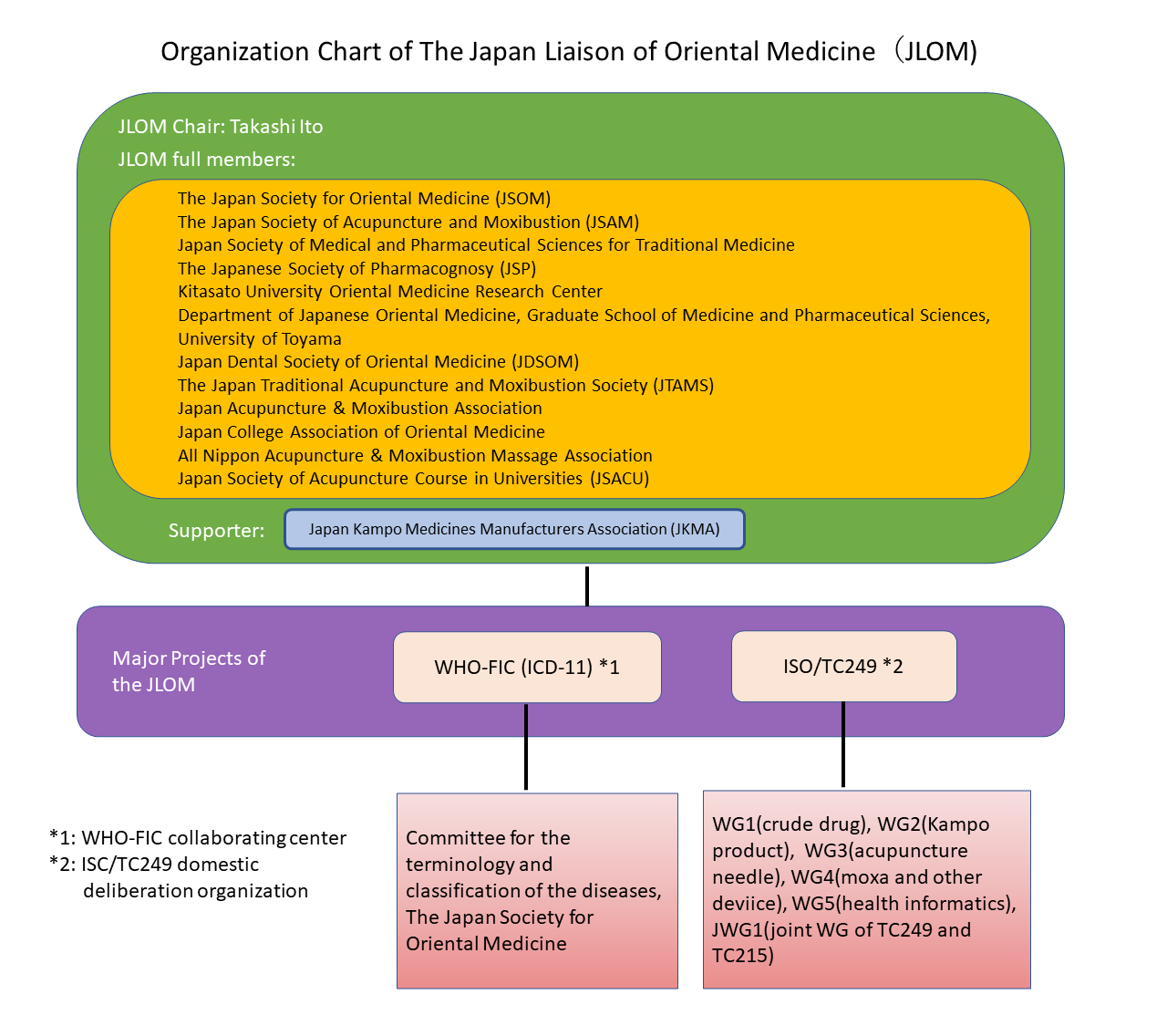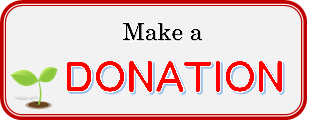About JLOM
The Japan Liaison of Oriental Medicine (JLOM) was established in May 2005, composed of four academic societies and two WHO cooperation centers in the field of traditional medicine in Japan. The mission of the JLOM is to summarize the opinions of Japan regarding international standardization activities of traditional medicine led by the WHO or ISO (International Organization for Standardization). The JLOM also acts as a platform for Japanese to submit proposals to international organizations. The number of member organizations of the JLOM has increased, and now there are a total of 12 organizations (see the organization chart below).
As activities related to the WHO, the JLOM has participated in and contributed to the establishment of ICD-11 (International Classification of Diseases 11th Revision) since the beginning, and it was approved at the WHO General Assembly in May 2019. The JLOM will promote the dissemination of the traditional medicine chapter of ICD-11 in Japan and prepare to obtain the approval of WHO regarding ICHI (International Classification of Health Interventions). Thus, the JLOM is making international contributions in the field of traditional medicine, taking a leadership role in the development of standards.
China applied to the ISO for the establishment of a technical committee (TC249) for standardizing traditional Chinese medicine (TCM), and it was approved in 2009. Since international standards related to traditional medicine have a marked influence on Kampo medicine as well as on acupuncture and moxibustion in Japan, the JLOM will stand at the forefront as a domestic deliberation organization of TC249. JLOM hosted the 5th general meeting (Kyoto) in 2014 and dispatches human resources to the ISO/TC249 general meeting every year.
<The JLOM’s point of view regarding traditional medicine>
The JLOM considers the diversity of traditional medicine to be the most important. Traditional medicine in each country and area has the same basic principle, but each traditional medicine has been inherited and developed in accordance with its own climate and culture. In other words, traditional medicine shows inherent diversity, and the JLOM considers that it is important to recognize this diversity. Unifying traditional medicine with one system leads to the denial of its diversity, and may hinder its future development. Traditional medicine practiced in each country and area should be recognized as equal, and developed to a higher level through mutual exchange. Therefore, the JLOM accepts international standards regarding points that can be mutually agreed upon, but if not, the JLOM prefers to respect the characteristics of each traditional medicine rather than establishing international standards.
<The JLOM’s ISO activity>
Since the primary purpose of standardization in the ISO is to determine the standard of "things", its activities should basically be carried out by the manufacturer. If the manufacturer is aiming for the international expansion of products, it is necessary to proceed with ISO activities. In ISO activities, the JLOM proposes a draft of standardization to the TC, and discusses proposals submitted by other member countries. In both cases, the JLOM summarizes the opinions of experts from manufacturers, academia, users, government officials, and ISO experts, and makes a comprehensive decision.
The title of TC249 is “traditional Chinese medicine (TCM)”, but since it deals with items related to medical and health care in East Asian traditional medicine, it may have a marked influence on the standards of each country. Thus, the JLOM should be careful regarding the proposals and decisions of the TC. In the “WMA (World Medical Association) Council Resolution on Trade Agreements and Public Health” adopted in Oslo in April 2015, it states:
" Ensure trade agreements do not interfere with governments’ ability to regulate health and health care, or to guarantee a right to health for all.”
(https://www.wma.net/policies-post/wma-council-resolution-on-trade-agreements-and-public-health/)
The same thing should be ensured for the ISO. However, this is not always the case, and it may affect Japanese standards, so it is important to consider how to respond to individual proposals.
<From the establishment of TC249 to the present>
The establishment of TC249 was officially approved by the ISO in June 2009. As a result, the JLOM was certified by the JISC (Japanese Industrial Standards Committee) as a domestic deliberation organization for TC249. Each ISO TC has a theme (title) for standardization, and the “title” of TC249 was tentatively set as TCM (traditional Chinese medicine). However, on approving the “title” as TCM, traditional medicine would be standardized by one system of one country, and so the diversity of traditional medicine would be lost. Therefore, some member countries including Japan opposed this, but the “title” was eventually approved as TCM at the 6th meeting and TMB (Technical Management Council) held in June 2015.
In addition to the “title”, TC has its “scope” (jurisdiction range). The “scope” defines what kind of projects should be standardized and handled. Currently, the scope of TC249 is:
"Standardization in the field of medical systems derived from ancient Chinese medicine, which shall be able to share one common set of standards. Both traditional and modern aspects of these systems are covered. The committee focuses on quality and safety of raw materials, manufactured products, and medical devices and of informatics, including service standards limited to involving the safe use and delivery of devices & medicine, but not into the clinical practice or application of those products. "
(https://www.iso.org/committee/598435.html)
However, this scope has a history of being decided directly by TMB without going through the discussions in TC249. Therefore, it is necessary to fully understand and familiarize oneself with the contents of this scope when dealing with the issue in TC249.
In ISO / TC249, the discussion is performed in six WGs (working groups), and China has made many proposals in each WG. In JWG1 (Joint working group 1), which is a joint venture with ISO / TC215 (Health informatics) and TC249, the deliberation of “health informatics” regarding traditional medicine is proceeding, creating a situation where proposals can be accepted more easily.
Under these circumstances, the JLOM's mission is to ensure that ISO resolutions do not change Japan's health care system, health policy, or education, promote Japanese health care, and, more importantly, protect the health of the Japanese citizen. It is also important to advocate Japanese standards about Kampo medicine which is a traditional Japanese medicine. Also, if there is a possibility of global expansion of original health products from Japan and if there is a domestic manufacturer that has an intention to do so, the JLOM will actively support it.
<About ICD-11 and ICHI>
ICD-11 that includes the Traditional Medicine Chapter, was approved at the WHO General Assembly in May 2019. It will go into effect in 2022, but the coding rule of ICD-11 should be disseminated in Japan by then. The ICD-11 Traditional Medicine Chapter has two major items: "Traditional medicine disorders" and "Traditional medicine patterns". The former lists “disorders” with their codes including those of five viscera or those of qi, blood, and fluid, etc., and the latter lists “patterns” with their codes including those of eight principal identification patterns or meridians and collateral patterns, etc. For Kampo medicine, it is necessary to work with a medical information manager to disseminate disease classification and coding. For acupuncture and moxibustion, it is necessary to prepare an appropriate recording system for disorders and patterns. JLOM and JLOM full member organizations should actively promote these activities.
Regarding ICHI, since it is a classification of medical intervention, acupuncture and moxibustion are more relevant than Kampo medicine in terms of intervention. ICHI has three axes: “target”, “action”, and “means”. At the meeting in Cologne, Germany held in February 2019, the “actions” for acupuncture and moxibustion were originally just two items: “acupuncture” and “moxibustion”. However, it has been changed as follows by the efforts of Japanese experts:
PZX.SP.AE Acupuncture, percutaneous
PZX.SP.AH Acupuncture, external
PZX.SQ.AH Moxibustion, external
Thus, “action” for acupuncture was divided into two: acupuncture percutaneous (penetrating acupuncture) and acupuncture external (non-penetrating acupuncture).
Also, at present, the “target” for acupuncture and moxibustion is described as "any site" in ICHI beta-3. In other words, regardless of where acupuncture or moxibustion is applied on the body, only "acupuncture" or "moxibustion" will be recorded and the location of the intervention will not. This is a very inadequate record of acupuncture and moxibustion practice. Therefore, Japanese experts are working hard to include 361 acupuncture points in the “target”.
<Future plans of the JLOM>
As mentioned earlier, the situation surrounding the ISO and WHO-FIC is constantly changing. The JLOM must flexibly respond to such changes, and, therefore, will continue the following activities:
- ISO and WHO-FIC activities
・Continue activities related to TC249 and TC215 (health informatics)
・Disseminate the ICD-11 Traditional Medicine Chapter throughout Japan, and propose adding 361 acupuncture points as the “target” of ICHI - Improve JLOM organization
・Improve the system of the JLOM so that it can sustainably assign experts to the ISO and WHO-FIC from academic societies and relevant domestic organizations
・Clarify the decision-making process while communicating and sharing information among all members
・Enhance the support system such as human and financial resources to achieve its own mission - Close cooperation with government agencies
・In addition to coordinating with administrative agencies under the jurisdiction, the JLOM will share information with other governmental administrative agencies.
<In conclusion>
The JLOM will continue to make efforts to achieve important outcomes in the field of ISO TC249/ 215 and WHO-FIC. The main goal is to protect traditional Japanese medicine, and more importantly the health of Japanese citizens. The JLOM would like to ask for support from related organizations and governments.
December 2020
Takashi Ito, Chair of the JLOM
JLOM Organization Chart

JLOM full members
The Japan Society for Oriental Medicine (JSOM) The Japan Society of Acupuncture and Moxibustion (JSAM) Japan Society of Medical and Pharmaceutical Sciences for Traditional Medicine The Japanese Society of Pharmacognosy (JSP) Kitasato University Oriental Medicine Research Center Department of Japanese Oriental Medicine, Graduate School of Medicine and Pharmaceutical Sciences, University of Toyama Japan Dental Society of Oriental Medicine (JDSOM) The Japan Traditional Acupuncture and Moxibustion Society (JTAMS) Japan Acupuncture & Moxibustion Association Japan College Association of Oriental Medicine All Nippon Acupuncture & Moxibustion Massage Association Japan Society of Acupuncture Course in Universities (JSACU)



